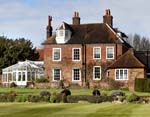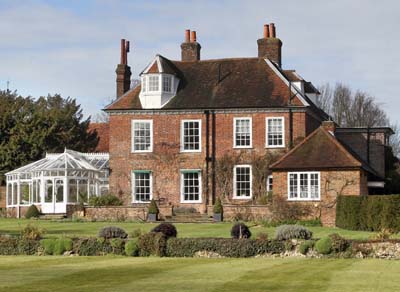Important country house sales
Sales of three country properties are likely to set the benchmark for top end rural property prices in their area for the rest of the year


With Easter safely out of the way, this week's Country Life sees the launch onto the market of three very special houses that not only exemplify the best of English country architecture, but could well set the benchmark for rural property prices in their respective areas for the rest of the year. That, at least, is the opinion of Tim Waring of Knight Frank in Harrogate (01423 530088), who is handling the sale of Grade II-listed Arthington Hall at Arthington, near Leeds, West Yorkshire, at a carefully pitched guide price of £2.95 million.
Originally built in the mid 15th century, the hall stands on the site of a former Cluniac nunnery endowed by the Arthington family in the late 1200s, and given by Henry VIII to Archbishop Cranmer in 1543, after the dissolution of the monasteries. Following a fire in the late 1700s, the house was substantially remodelled for Henry Arthington by Yorkshire architect John Carr, who was much in favour in Wharfedale at about that time, designing such illust-rious country houses as nearby Harewood House and Denton Park, and Farnley Hall at Otley.
This was a period when many rich Leeds merchants decided to swap the trading floor for the green and pleasant life of a country landowner-a condition that Carr himself aspired to. Born the son of a stonemason in 1723, he went on to become Yorkshire's dominant architect, a gentleman, twice Lord Mayor of York, and a justice of the peace for the West Riding, with his own country house and estate.
At Arthington Hall, Carr's most notable legacy is undoubtedly its famous flying staircase, described by the late Giles Worsley (Country Life, May 5, 1988) as a ‘masterpiece of joinery (and) one of Yorkshire's unknown 18th-century marvels'. Set in an oval stairwell, it starts with two flights that meet at a half-landing to form a central, unsupported flight that is said to ‘bounce unnervingly' when walked upon.
The route from Leeds to Wharfedale was already well-trodden by the time the Sheepshanks family (wool merchants, as the name suggests) bought Arthington Hall in 1842. In 1875, William Sheepshanks commissioned a Victorian extension by Alfred Waterhouse; a further wing was added in 1908. The hall has been the Sheepshanks family home ever since, apart from a period during and after the Second World War, when it was used as a convalescent home.
In the early 1990s, the present vendors, William and Alice Sheepshanks, bought Arthington from William's late mother, Mary, who, with his father, Charles, reclaimed the house and gardens in the 1960s and restored them to something like their former glory. Mr and Mrs Sheepshanks have carried on where his parents left off, but now they, too, are moving on, and Arthington Hall needs another busy family to take on the mantle of custodian.
Certainly, the task is not one for the faint-hearted, as the main house, set in 23 acres of gardens, woods and parkland, boasts four grand reception rooms, various family rooms, a large kitchen/breakfast room, eight bedrooms, two dressing rooms and five bathrooms-not to mention the attics, the north wing (converted to a two-bedroom staff flat), the three-bedroom Garden Flat, and the two-bedroom gate lodge. But the challenge pales into insignificance when compared with the spectacular beauty of the hall's setting on the banks of the River Wharfe, with views looking west over the valley to the arches of the Arthington Viaduct and Ilkley Moor in the distance. The sale includes fishing rights on the Wharfe, and shooting rights over the surrounding farmland.
Sign up for the Country Life Newsletter
Exquisite houses, the beauty of Nature, and how to get the most from your life, straight to your inbox.
In contrast to the rugged power of Arthington, elegant, Grade II*-listed The Knoll (pictured) in the Chiltern village of Penn, Buckinghamshire, is a model small country house set in 5.7 acres of immaculate gardens and grounds with views across the Thames Valley to Windsor Castle.

* Subscribe to Country Life and save £40%
Built in 1671 for the newlywed Nathaniel Curzon and his wife, Sarah Penn, the house stands next to the churchyard of Penn's oldest building, the 12th/14th-century Holy Trinity Church. Savills (01494 731950) quote a guide price of £4m for The Knoll, which has three main reception rooms, a conservatory, a kitchen/breakfast room, six bedrooms and three bathrooms, all beautifully refurbished by the present owners, who have lived there for 25 years.
Mellow red-brick walls support the roof of the house, and the interior is supported by a heavy oak frame, with original casement windows on the north side, and later sashes elsewhere. A tiled turret or belvedere in the roof is thought to have been built as an observatory by the Rev Benjamin Anderson, who lived at The Knoll for some years before becoming vicar in 1808.
From 1927 to 1939, it was the home of Sir George Robertson, a well-known classical scholar who threw the discus for Britain in the first modern Olympics of 1896. He failed to win a medal, but distinguished himself at the closing ceremony by reciting an ode he had composed, in ancient Greek and in Pindaric mode, in honour of the games. Later owners of The Knoll included Countess Howe, her son Viscount Curzon, and the discredited businessman Ernest Saunders.
Far from the madding crowd, the wonderfully unspoilt, 280-acre Roundhill estate at Charlton Musgrove, near Wincanton in Somerset, is being sold by the executors of the late Lady Dunphie, who died last year, at the grand old age of 101, having lived at Roundhill since 1955. Savills in Salisbury (01722 426800) quote a guide price of £6m for this ‘real gem of an estate', which is being offered as a whole, or in six lots.
Once part of the much larger Stavordale Priory estate owned by the Stourton family from the mid 1500s to the mid 1600s, the manor passed first to James Churchey, then to his son, and other descendants, before being sold in 1831 to George Wyndham. His son, Henry, sold the estate in 1873, since when it has passed through a number of hands.
Roundhill Grange, listed Grade II, is the main house on the estate, which also includes four cottages and a mix of traditional and modern farm buildings. First recorded in the 1530s, the Grange is said to have been built in 1701 on the site of an earlier mansion, the remaining parts of which were demolished in 1832, when the grounds were altered and new stables built.
Built of red brick with Doulting-stone dressings, the house is now two storeys, although it probably had attics in a steeply pitched roof, which was replaced by a low parapet in the 18th century. The interior was altered and redecorated in about 1835, when 17th-century panelled-oak doors were added, with single-storey kitchens installed to the north. In the late 19th century, the main panelled room on the first floor was rearranged to accommodate two staircases, and the roof was reconstructed. Then, or early in the 20th century, an upper floor was added above the kitchens.
After more or less constant alteration throughout the first three centuries of its existence, Roundhill Grange remained mercifully untouched during Lady Dunphie's tenure, and there is now a unique opportunity for someone to create a classic country estate in a gloriously peaceful setting. The house is not over-large, having three main reception rooms, a kitchen/breakfast room, a master suite, six bedrooms and two bathrooms on the first floor, with a housekeeper's room, seven attic rooms and a bathroom on the second floor.
Roundhill Grange is surrounded on three sides by majestic parkland, with gently undulating grassland providing first-class grazing for horses and livestock. Running south-west from the Grange can be seen the remnants of the former drive and avenue, which could be reinstated subject to the relevant planning consents.
Country Life is unlike any other magazine: the only glossy weekly on the newsstand and the only magazine that has been guest-edited by HRH The King not once, but twice. It is a celebration of modern rural life and all its diverse joys and pleasures — that was first published in Queen Victoria's Diamond Jubilee year. Our eclectic mixture of witty and informative content — from the most up-to-date property news and commentary and a coveted glimpse inside some of the UK's best houses and gardens, to gardening, the arts and interior design, written by experts in their field — still cannot be found in print or online, anywhere else.
-
 380 acres and 90 bedrooms on the £25m private island being sold by one of Britain's top music producers
380 acres and 90 bedrooms on the £25m private island being sold by one of Britain's top music producersStormzy, Rihanna and the Rolling Stones are just a part of the story at Osea Island, a dot on the map in the seas off Essex.
By Lotte Brundle Published
-
 'A delicious chance to step back in time and bask in the best of Britain': An insider's guide to The Season
'A delicious chance to step back in time and bask in the best of Britain': An insider's guide to The SeasonHere's how to navigate this summer's top events in style, from those who know best.
By Madeleine Silver Published
